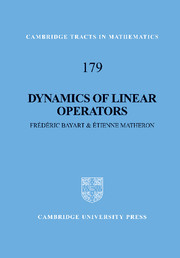Book contents
- Frontmatter
- Contents
- Introduction
- 1 Hypercyclic and supercyclic operators
- 2 Hypercyclicity everywhere
- 3 Connectedness and hypercyclicity
- 4 Weakly mixing operators
- 5 Ergodic theory and linear dynamics
- 6 Beyond hypercyclicity
- 7 Common hypercyclic vectors
- 8 Hypercyclic subspaces
- 9 Supercyclicity and the Angle Criterion
- 10 Linear dynamics and the weak topology
- 11 Universality of the Riemann zeta function
- 12 An introduction to Read-type operators
- Appendices
- References
- Notation
- Author index
- Subject index
8 - Hypercyclic subspaces
Published online by Cambridge University Press: 10 December 2009
- Frontmatter
- Contents
- Introduction
- 1 Hypercyclic and supercyclic operators
- 2 Hypercyclicity everywhere
- 3 Connectedness and hypercyclicity
- 4 Weakly mixing operators
- 5 Ergodic theory and linear dynamics
- 6 Beyond hypercyclicity
- 7 Common hypercyclic vectors
- 8 Hypercyclic subspaces
- 9 Supercyclicity and the Angle Criterion
- 10 Linear dynamics and the weak topology
- 11 Universality of the Riemann zeta function
- 12 An introduction to Read-type operators
- Appendices
- References
- Notation
- Author index
- Subject index
Summary
Introduction
In Chapter 1, we observed that the set of hypercyclic vectors of any hypercyclic operator T has a rich algebraic structure: there exists a dense linear subspace of the underlying space X consisting entirely of hypercyclic vectors, except 0.
It may also happen that HC(T) contains a closed infinite-dimensional subspace (except 0). This is the topic that we will consider in this chapter. For brevity, we adopt the following terminology: by a hypercyclic subspace for an operator T ∈ L(X), we shall always mean a closed infinite-dimensional subspace Z ⊂ X such that Z \ {0} ⊂ HC(T).
Our main goal in this chapter is to prove the two theorems stated below, which show that hypercyclic subspaces exist under quite natural assumptions. For simplicity, we will restrict ourselves to the case of Banach space operators.
The following basic result is due to A. Montes-Rodríguez [183].
THEOREM 8.1 Let X be a separable Banach space, and let T ∈ L(X). Assume that the following hold for some increasing sequence of integers (nk).
T satisfies the Hypercyclicity Criterion with respect to (nk).
There exists a closed infinite-dimensional subspace E ⊂ X such that Tnk (x) → 0 for all x ∈ E.
Then T has a hypercyclic subspace.
It is important to note that properties (1) and (2) in Theorem 8.1 have to be satisfied by the same sequence (nk). However, it turns out that this restriction is in fact not necessary.
- Type
- Chapter
- Information
- Dynamics of Linear Operators , pp. 195 - 217Publisher: Cambridge University PressPrint publication year: 2009



